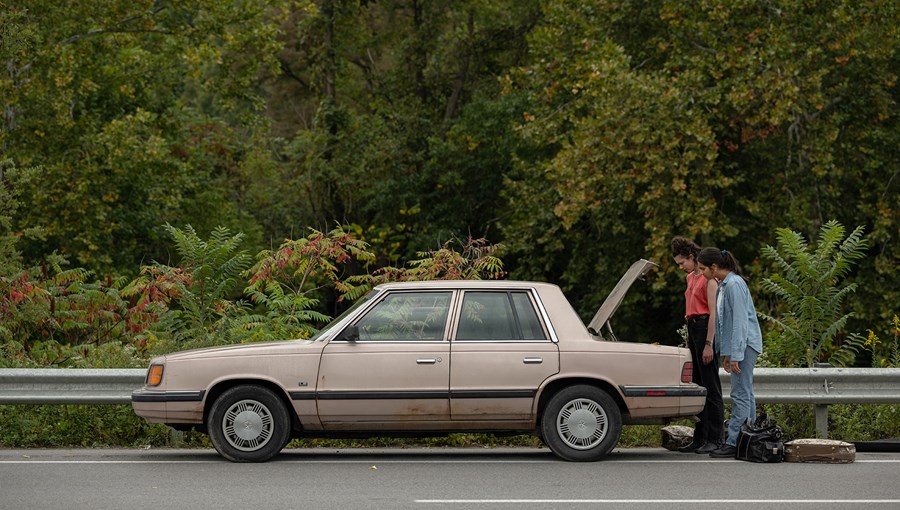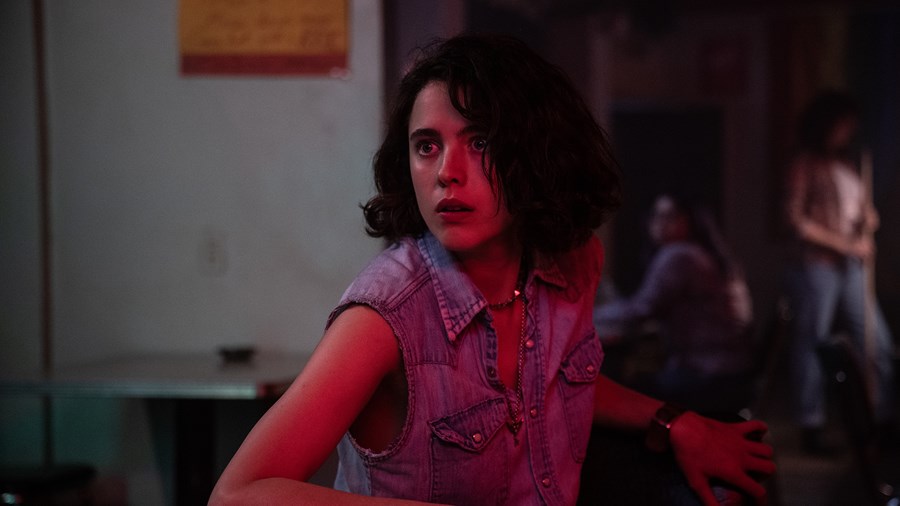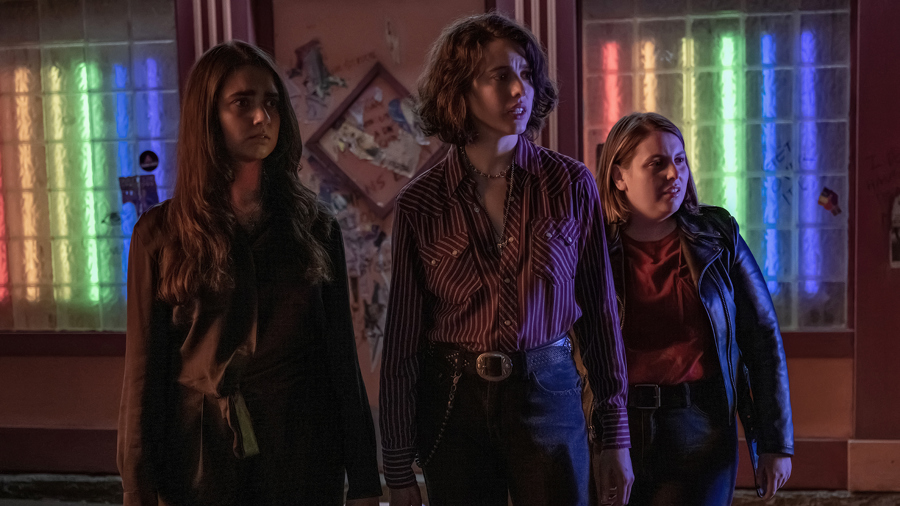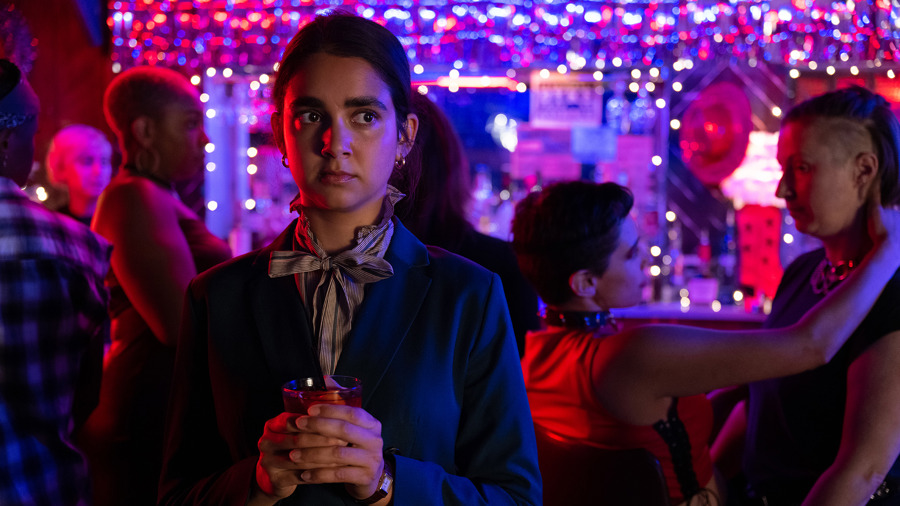Ethan Coen and Tricia Cooke’s bawdy sex comedy borrows from high-school farces, with one crucial difference: it puts queer female sexuality front and centre. By Billie Walker

‘I’ve had it with love, I don’t think it’s relevant to the 21st-century lesbian,’ moans a defeated Jamie (Margaret Qualley) after being dumped by Sukie (Beanie Feldstein). Her reserved best friend Marian (Geraldine Viswanathan), also queer and going through a very dry spell in her sex life, is similarly frustrated with her lot. And so begins Drive-Away Dolls – the first movie by the married filmmaking duo Ethan Coen (yes that Coen) and Tricia Cooke – with two friends determined to shake up their ideas by embarking on a road trip to Florida, and Jamie plotting to both have a fling and set one up for Marian. It wouldn’t be a Coen (singular) film without a lick of crime, so, in addition to the sexcapades, the pair are pursued by hitmen seeking to retrieve the mysterious goods stowed in Marian and Jamie’s rental-car boot.

Drive-Away Dolls (2024)
How does every journey of self-discovery begin? With a plan to get laid, of course. At least, that’s the normal route to introspection for turn-of-the-century (inevitably male-fronted) teen comedies. Take the nerdy boys of Superbad (2007), who are determined to leave high school with a notch on the proverbial bedpost. Or the horny young men of the American Pie series (1999-2012) who spend four films trying to change their luck with women. In Noughties teen movies, lewd bedroom antics are primarily focalised through the male protagonist. In Superbad, Seth (Jonah Hill) remarks on how girls say ‘I was so gone [i.e. drunk] last night, I shouldn’t have slept with that guy’, concluding that he and Evan (Michael Cera) ‘could be that mistake!’ Female pleasure is rarely an objective in these films and, more often than not, the women are simply a narrative necessity for the men to accomplish their sexual goals. According to such films, teenage girls are the passive object of desire, and their sexuality wasn’t depicted on screen because of hypocritical attitudes towards female virginity.

Drive-Away Dolls differs greatly in this respect, because Marian and Jamie’s carnal appetites are paramount: they are undoubtedly lascivious and on a quest for sexual satisfaction. Male desire is notably absent in this queer female story, and is easily substituted with diverse dildos, as in Jamie’s awkward break-up scene where Sukie is desperately unscrewing a mounted wall appendage. The film boasts a constant supply of bawdy cunnilingus one-liners – tossed off with deadpan delivery by the cast – which are in keeping with the crude humour of the high-school comedy (though, crucially, these jokes are by women and empower women’s pleasure). In returning to the beginning of the millennium with its 1999 setting, Drive-Away Dolls reclaims this comedy subgenre for a queer audience.

Drive-Away Dolls (2024)
Unlike the misogynistic teen comedies that came before, the female-led equivalent – which has gained momentum in recent years – centres consent, reciprocal pleasure and queerness. Since Kay Cannon’s Blockers (2018), about three adolescent girls (one of whom played by Drive-Away Dolls’ Viswanathan) making a pact to lose their virginity on prom night, there have been many more women-led comedies detailing the search for the female orgasm. Olivia Wilde’s Booksmart (2019) – reductively dubbed ‘the female Superbad’ for its one-wild-night plot – shares a queer-romance storyline with Blockers, since Kaitlyn Dever’s out student is seeking to hook up with her skater-girl crush. Similarly, Emma Seligman’s Bottoms (2023) follows the lesbian friends PJ (Rachel Sennott) and Josie (Ayo Edebiri) as they form an all-girls fight club in an attempt to have sex with cheerleaders. Seligman flips the script on the common trope of men trying to win over the squad, as seen previously in Fired Up (2009). Finally, queer female sexuality is getting the comical spotlight it deserves, allowing women to be just as open about their frustrations to get laid as their male counterparts.

Drive-Away Dolls (2024)
But Drive-Away Dolls holds much more than myriad jokes on ‘finger jiggle[s] in your clit’ and tongue play. It also shows us something we don’t see all too often: a woman’s sexual awakening. With a recurring flashback of Marian’s childhood, the audience is introduced to her budding desire. As young Marian (Samsara Leela Yett) jumps on her trampoline, her female neighbour, sunbathing naked, is just visible next door over the white picket fence. It’s a moment that could, in the wrong hands, feel perverted, like the time Stifler (Seann William Scott) places spycams in the girls’ locker room in American Pie Presents: Band Camp (2005). But the soft silence, broken only by the creaking springs below Marian’s feet, is a gentle reminder of her innate queerness and blossoming curiosity. Drive-Away Dolls may herald from the high-school comedy, but it has real moments of tenderness. Marian’s toenails in this early memory are painted electric blue, the same colour she wears in her adult life in a nod to her ever-questing libido. Despite its brash humour, the film is delicate in its handling of female desire, which separates it from the majority of early-2000s efforts.

Drive-Away Dolls (2024)
Drive-Away Dolls may draw from teen comedies, but it depicts two grown women, meaning the stakes are higher, the sex is rawer and the orgasms are more explosive than the high-school movie could handle. The movie merges Ethan Coen’s crime-thriller past with Tricia Cooke’s queering of farcical tropes to create the most outrageous lesbian buddy comedy imaginable. Its crime-dodging, dildo-wagging duo, who share an unshakeable bond and insatiable thirst, are destined to enter into the queer comedic canon.
WATCH DRIVE-AWAY DOLLS IN CINEMAS




